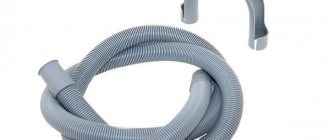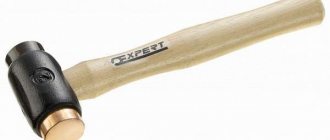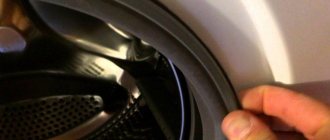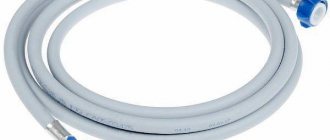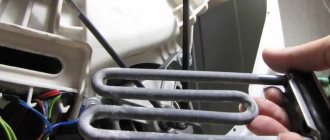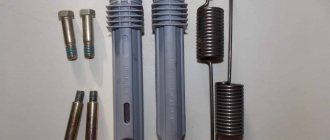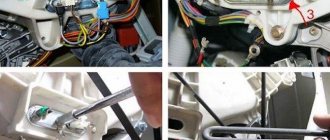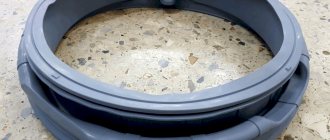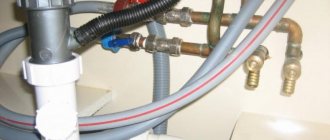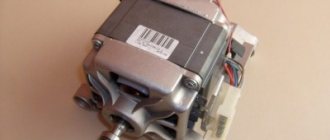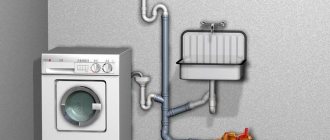It happens that immediately after purchasing or moving it is discovered that the drain hose of the washing machine has broken, is leaking or does not reach the sewer. Needs repair, replacement or extension. Let's figure out how to do this at home with your own hands.
The manual is relevant for the following models of washing machines: Ardo / Ardo, Beko / Beko / Veko, Bosch Avantixx, Classixx, Logixx, Maxx, SportLine / Bosch Avantix, Classic / Classic, Logix, Max, Sportline; Brandt / Brandt, Candy Aquamatic, Holiday, CNE, CTS / Candy Aquamatic, Holiday; Daewoo / Daewoo, DEXP / Dexp, Electrolux Time Manager / Electrolux, excuse me, Timemanager, Evgo / Evgo, Gorenje / Gorenje, Haier / Hayer, Hansa / Hansa, Hotpoint Ariston Margherita, RSM, ARSL, ARWM / Hotpoint Ariston Margherita, Indesit IWSB , WISL, WISN, WITL, Innex / Indesit Wisl, Inex; LG / LJ/LV; Miele / Miele, Samsung Diamond, WF, EcoBubble, Bio Compact / Samsung Diamond, Eco Bubble, Bio Compact; Siemens / Siemens, Vestel / Vestel, Whirlpool AWG / Whirlpool, Zanussi Aquacycle, EcoValve / Zanussi Aquacycle, EcoValve; Atlant, Vyatka, Desna, Donbass, Malyutka-2, Saturn, Siberia, Fairy-2, Eureka-3 and other brands with vertical and horizontal loading, automatic and semi-automatic.
To start
Remember two main rules that must be followed before any repair work on household appliances.
Shut off the water
Close the water supply shut-off valves. They are usually located behind the washing machine on pipes. Now, even if the hose is damaged during operation, water will not flow.
De-energize
Remove the plug from the socket. To keep the wire out of the way, you can attach it with paper tape or wire to the back wall of the washing machine.
Preparing tools and materials
Before you begin repairing, replacing, or extending the drain hose, make sure you have everything you need on hand:
- pliers;
- screwdrivers;
- fastenings - metal clamp, coupling or adapter;
- sealant, we recommend using silicone;
- water for washing and cleaning;
- brush or cable;
- the spare parts themselves.
Connection Features
Before extending the drain, it is useful to understand its geometry. Usually the washing machine is equipped with a drain hose. If necessary, it is lengthened. The main thing is to do it correctly so that there are no leaks. To do this, use a special adapter connector. It is prohibited to place the drain hose higher than 100 cm - this limitation is due to the low power of the pump. When connecting it to the machine in any way, you should ensure free tension. The lifting height of the pump must exceed the bottom edge of the device by 60 cm.
Step-by-step instruction
Most often, the length of the drain hose reaches about two meters. But on average it is 1.5 m. If your machine is installed in such a way that the standard size is not enough, you can increase the tube or buy another one in a specialized store.
Lengthen standard
The easiest way to extend a drain hose is to attach another one to the existing one. For example, from an old typewriter. Or buy a new one. Moreover, there are at least two ways to lengthen it.
For the first you will need a special plastic adapter (coupling):
- Place the ends of the parts onto the connector.
- Tighten the clamps on both sides.
- Run a test wash.
- If water leaks at the connection, tighten the clamps more tightly and apply silicone sealant.
For the second method, you need a piece of plastic or rubber tube with a diameter slightly smaller than the diameter of the hoses. Their ends must be put on this improvised extension cord and aligned. The connection must be tight. Place the clamps on top and tighten tightly. Run the wash and check the tightness.
Put a new one
If you are not sure that the extended hose will be leak-proof and will last a long time, it is better to buy a new one of the right size.
To replace it, you will have to disassemble the body of the washing machine.
A drain tube is attached to the pump to drain dirty water. This is where you need to get.
Universal instructions for disassembling washing machines: 23 videos for all brands
Depending on the brand of the washing machine, the pump can be located anywhere: bottom, side, back. Therefore, before repair work, carefully read the universal instructions located above.
First of all, use a screwdriver to unscrew all the fasteners and open access to the pump. If it is uncomfortable to work with, place the machine on its side. Make sure that the electronic control module is at the top.
Further:
- If there is any remaining water in the drain tube, drain it. You can put a rag or a basin under the pump.
- Remove the fasteners from the part of the siphon to which the pipe is connected.
- If a check valve is installed on the drain, unscrew it.
- Use a flathead screwdriver to loosen the bolts on the pump and pipes.
- Remove the drain pump.
- Use pliers to loosen the clamp and disconnect the hose.
- Carefully remove it.
- Attach the new tube to the pump.
- Replace the pump.
- Connect the drainage tube to the drain (sewer, siphon or check valve).
- Reattach the external/internal bolts, fasteners and clamps.
Washing machine drain hose extension
The drain hose can be extended with or without a plastic connector. If such a device is available, the procedure is as follows:
- Place clamps on the ends of both parts.
- Place the extendable drain hose coming from the washing machine onto the connector.
- Place the purchased drain tube onto the device.
- Tighten the clamps using a screwdriver or other tool. It is important to ensure that the connection is tight.
- Connect the washing machine to the sewer and run the wash in test mode to evaluate the quality of the extension.
While the washing machine is operating, you need to monitor the connection location. If it leaks, tighten the clamps tighter or replace the components.
To extend the drain hose without an adapter, use a rubber or plastic tube of suitable diameter. The existing drain and the purchased part are pulled onto it from both sides so that they can be connected in the center and they fit very tightly. Both parts are tightened with clamps to secure the connection.
Recommendations and tips
Before repairing, extending or replacing the hose, use a tape measure to measure the distance from the pump to the drain. And add 5 to 10 centimeters to the result. The drainage tube should not be stretched.
Where is
- Brands Ariston, Samsung, Indesit, Ardo, LG.
Location at the bottom of the unit. To gain free access, you need to tilt the machine, then unscrew the bolts on the cover and drain filter.
- Zanussi and Elektrolux.
To access the hose in these brands, you need to open the panel by unscrewing the screws that hold the top cover. It also needs to be removed along with the back of the case.
- Beko top loading washing machines.
In models of this brand, the pump is located on the side panel. For repair work, you need to unscrew and remove the metal cover.
Standard sizes and diameters
Hoses can be regular, 1-5m long, or corrugated (telescopic). When compressed they are only 60 cm, and when extended they are 2 m.
According to experts who carry out repair work on household appliances, it is not recommended to install hoses in washing machines whose maximum length exceeds 3.5 m. The power of the drain pump is designed for a certain distance leading to the sewer pipe. If it is too large, then the pump is overloaded. Accordingly, the part quickly fails. And electricity is not used economically.
Rubber tips - fittings - are installed at the ends of the drain tube. The outer size of the fitting is the working diameter. Most manufacturers make a diameter of 19 or 22 mm at both ends. Sometimes one end may be 22mm and the other 19mm. In some modern models, the diameter of the nozzle for connecting to the pump reaches 29 mm. For example, LG.
When replacement is required
You will have to buy a new hose if:
- The old one is worn out and leaking.
- It bent and broke.
- It is clogged to such an extent that simply cleaning it is no longer an option. This happens with the gradual accumulation of limescale or soap deposits, grease, hair, threads, etc.
Methods for organizing drainage
The main rule is that the end of the drain tube should be located at a height of 50 cm from the floor. If it is lower, then you can get a “siphon effect”: water from the sewer will return to the drum. If it is higher, the pump will start to wear out and waste electricity.
So, three options for the location of the drain.
- The end of the hose can be attached to a sink, bathtub or toilet using a special hook. The method is simple, but not very convenient.
- Connection to a siphon if the washing machine is located near the washbasin.
- Connection directly to the sewer pipe.
Step-by-step instructions for connecting any washing machine
If the water drain hose is too short
Basically, machines have drain hoses of a standard size, approximately 1.5 meters.
With the correct layout of the room, there should be no problems with installing the washing machine.
But what to do if the washing machine has a short drain hose and is not enough to connect to the sewer pipe? Panic thoughts appear, followed by a question:
Is it possible to extend the drain hose of a washing machine?
Certainly. There are three ways to solve the problem:
Call a plumber.- Replace the hose with a longer one at the service center.
- Figure out how to lengthen the drain hose and solve the problem yourself.
The first two options are easy, but will require some financial investment.
The hose extension procedure itself is simple and does not require specific knowledge. Basically, there is no need to disassemble the equipment.
The main thing here is to choose the right part to replace!
Replacing the hose
Each washing machine model is individual, that is, the drain is attached in different ways. But there are basic rules, regardless of the brand of washing machine:
- First you need to turn off the power. The cord must be secured to the back of the washing machine so that it does not get in the way during work.
- Next, the water supply is turned off. When disconnecting the hose, the main thing is not to lose the gasket that is located in this tube. In the place where the drain was attached, you need to install a plug, and attach the hose directly to the back of the washing machine with the pipe facing the top.
- To replace the hose, access to the internal elements of the machine is required. As a rule, the hose is attached near the pump. For ease of work, you need to unscrew the top roof of the housing. The hose most often protrudes from the top or bottom of the back of the washer. To replace it, you need to unscrew it from the pump and housing.
- The hose is then disconnected from the sewer system. Now we begin to install the new product. All washing machine models do this in different ways, so it is recommended to study the instructions.
The maximum hose length is most often standard, especially when it comes to diameter. If any of the fittings of the washing machine are non-standard, then you need to specially order a hose or increase the length. Something you can easily handle with your own hands.
How to extend an inlet hose
If the length of the filler tube is not enough, it is easier not to increase it, but to connect a new part. You can purchase it in the same department as the components of the drainage system. To replace the tube, you do not need to disassemble the device itself. The procedure in this case will be as follows:
- If the automatic machine is already connected to the water supply system, turn it off and disconnect the tubes.
- Unscrew the fasteners without using tools. So, the plastic parts will remain intact.
- Install the new tube and tighten the fasteners also by hand without using tools.
- Open the water supply and check how tight the connections are.
- Run a wash to test the new filler tube.
Important! If you cannot find a filler tube of the required length on sale. Its size can be increased. To do this, you will need a similar water supply hose and an adapter. A 3x4 inch brass nipple is used for this. The tubes are simply screwed onto it from both sides.
After expanding or replacing parts, you need to make sure that the cable is long enough to connect the device to the power supply. It is best not to use extension cords or filters with multiple outlets for your washing machine. Such a connection is unreliable and is quite capable of causing a fire.
Varieties
Before you begin lengthening, you need to familiarize yourself with the main types of hoses.
Jellied
The inlet hose is a device used to connect the washing machine to the water supply system. It is with its help that water is supplied to the internal elements of the system. Such products operate under high pressure conditions and therefore reinforcement technology is used in their manufacture.
The main material from which the filler tubes are made is polyvinyl chloride, the surface of which is covered with nylon.
The connecting components of the structure can be made of steel, aluminum or plastic. Budget models use plastic fittings that are unscrewed and screwed on manually, without the use of additional tools. When working with steel or aluminum products, you will have to use a special wrench.
Drain
A drain hose is used to drain liquid from washing equipment. The following types of drain tubes are distinguished:
- Standard. Such products are produced in a certain length, the length of which can reach five meters.
- Telescopic. These are corrugated products that can easily be stretched to the desired length. When connecting telescopic tubes, you must be very careful so that they do not bend. The kinks may burst under strong pressure.
- Polypropylene. They are made from durable polypropylene. At each end of the product there are special fittings with which a device for washing clothes is connected.
See also
Reasons why the washing machine may not spin and what to do

